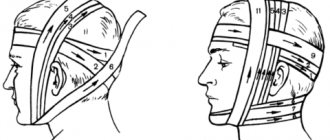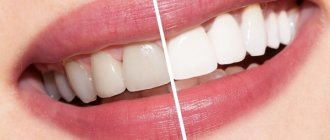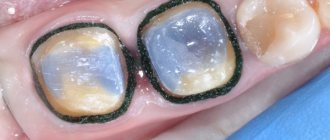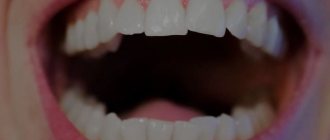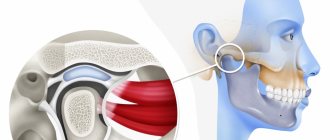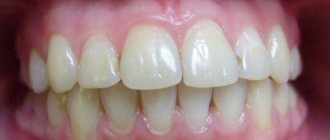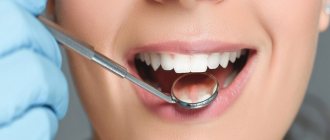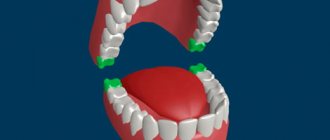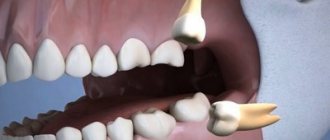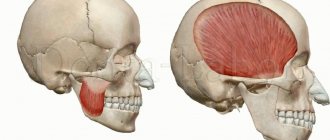Jaw expansion is a process of correction of jaw tissue, which is necessary in case of crowding of teeth, narrowing of the jaw arch, if the jaw is narrow, teeth are placed unevenly, etc. All these anomalies noticeably spoil the aesthetics of appearance, but, fortunately, modern orthodontic techniques can effectively solve the problem .
The bone expansion procedure is recommended for the following diagnoses:
- micrognathia (underdevelopment of the jaw);
- microgenia (underdevelopment of the lower jaw);
- incisor protrusion (a pathology in which the front teeth are tilted too forward);
- mesial occlusion (impaired closure of tooth rows);
- cross bite or crossing of the jaws;
- narrowing of the apical base and reduction in the perimeter of the jaw arch.
Description of the pathology
The normal shape of a row of permanent teeth resembles an elongated horseshoe. The lower jaw is naturally slightly narrower than the upper jaw - this is necessary for better closure of teeth and chewing food.
Narrowing of the jaw is called its reduction in diameter - the appearance of a “dent”. This happens more often with the top than with the bottom. It is formed by more porous bone and is more closely connected in the patterns of its development with the upper palate and other elements of the skull. But in fact, the process can affect both jaws, only the right or left side of one of them, or even both.
Another weak but obvious pattern is the increased frequency of curvature in the premolar area (4-5 teeth on each side), while “concave” anterior teeth are less common.
Why is a small chin bad?
Try a little experiment. Take a full-face photo of yourself and mentally divide your face into three parts: the upper one - from the hairline to the eyebrow area, the middle one - from the eyebrow area to the tip of the nose, and the bottom one - from the tip of the nose to the base of the chin.
Now arm yourself with a ruler and see if these parts are equal to each other. Equal? Congratulations – your face has the correct proportions. Not equal? What third violates the harmony of features? There is a very high probability that the lower part of the face is to blame for the occurrence of disproportion.
The basic laws of beautiful facial proportions - the “rule of three thirds” - were formulated by Leonardo Da Vinci.
Therefore, in order to improve your appearance as a whole, it is enough to simply “build up” your chin a little. Is it possible? Maybe. At Platinental we do this every day.
Varieties
This disease has several variants.
- Narrowing of the dentition along the entire length. Its typical sign is the appearance of a “horse” smile due to the fan-shaped incisors.
- Trapezoidal deformity. With it, the patient's jaw takes on the shape of a trapezoid with clearly visible visually defined angles in the area of growth of the 3rd incisor or 1st premolar.
- Narrowing in the anterior region. Here the incisors converge like a wedge and “climb” onto each other.
- Saddle defect. With it, the row is “dented” inward at the level of the premolars (4 and 5 units on each side) with 6 and/or 7 molars. And the incisors and “eights” are usually positioned correctly, or they may be moderately crowded and rotated.
- Asymmetry. This depression is observed only on one side, but, as a rule, affects both jaws. Often combined with normal occlusion in other areas.
All of them can be I, II or III degrees of severity. The pathology first appears in childhood, as temporary teeth are replaced with permanent ones. In adolescence and adulthood, consolidation of malocclusion leads to a change in the load on the mandibular joint, spreading secondary deformations to healthy areas.
The narrowing of the upper jaw is also accompanied by a deepening of the palatine vault and makes nasal breathing difficult. Plus, these processes provoke uneven wear of crowns and can lead to underdevelopment of units that do not have enough space.
Causes
The most difficult reason in terms of prevention and treatment for a narrowing of the upper or lower jaw by 2 teeth or more (II degree and higher) is unfavorable heredity, since most of the structural features of the skull are determined at the genetic level. But other factors related to childhood also make a significant contribution:
- delay in introducing complementary foods;
- habit of thumb or pacifier sucking;
- early loss of baby teeth, especially molars or several units in a row on one side (the lack of chewing load in this area interferes with bone development);
- lack of solid food in the diet;
- metabolic disorders - rickets, type I diabetes mellitus, etc.;
- parafunction (unjustified increased activity of a nervous nature) of masticatory or facial muscles, including bruxism, involuntary movements of the tongue, etc.;
- rhinitis, sinusitis, tonsillitis, polyps and other diseases that force the child to breathe more often through the mouth than through the nose;
- injuries.
It can also be provoked by a cleft palate, caused by a delay in intrauterine development.
Treatment and prevention
The choice of treatment technique is determined by the clinical picture of the development of the pathology, as well as the age group to which the patient belongs. The main vector of therapy is to stimulate the development and growth of the lower jaw.
In childhood
The period of primary occlusion is one of the most favorable in terms of correction possibilities, since it allows the use of gentle treatment methods. The main methods used at this stage are:
- prosthetics for prematurely fallen milk teeth, ensuring the preservation of the normal shape of the jaw arch;
- sanitation of the oral cavity, accompanied by the restoration of individual damaged teeth and cleaning of defective roots;
- grinding of the areas of jaw closure - fissures - which allows you to eliminate malocclusion in the form of bumps on the chewing surface;
- normalization of breathing and tongue function, including by trimming the lingual frenulum and correcting the nasal septum;
- use of special corrective trays, plates or nipples.
Quite often, in order to stop the primary signs of pathology, it is enough to wean young children from bad habits.
As an adult
The treatment method during the period of permanent or mixed dentition is determined by the specifics of the anomaly.
To treat prognathia at the variable stage, special corrective orthodontic appliances, such as a Frenkel adjuster, a facebow or a Herbst device, can be used. Microdentia is treated with the help of distractors - devices that stretch the bone tissue and then replace it in the jaw with new bone.
At the permanent stage of occlusion, the most effective method is jaw surgery, which involves removing part of the dentition and excision of the alveolar-ridge area. It is also possible to use a radical technique - plastic surgery, in which the lower jaw is broken off from the main bone and moved forward, and in its place new bone material is placed, fixed with special plates.
The easiest way to avoid orthodontic intervention and stimulate the normal development of the lower jaw is in childhood - to do this, it is enough to follow simple preventive measures, prevent the development of bad habits and contact specialists at the first signs of pathology.
Diagnostics
It is not difficult to determine the narrowing of the jaw in a child or adult during an external examination. Its clear sign is the “pressed-in” dentition in certain areas or along the entire length with partially expanded, crowded units. Another characteristic feature is malocclusion.
At the same time, it is necessary to distinguish pathologies of jaw development from atypical orthodontic and dental situations such as supernumerary units, macrodentia, individual structural features of the skull, etc. They can also be combined. Therefore, a preliminary diagnosis made visually is confirmed with the help of one or more additional studies:
- According to Pon-Linder-Hunt , where the difference between the normal and existing width of the dental arch for a given patient is calculated using a special formula. The method requires taking several measurements directly in the oral cavity and taking into account different indicators for representatives of individual nations. But it gives the attending physician a fairly accurate answer to the question of whether several units will have to be removed to level the entire row.
- According to Howell-Gerber-Gerbst - another relatively complex mathematical scheme that is well suited for measuring the shape, length, width and other individual parameters of a row.
- Teleradiography is a type of X-ray examination that allows you to take a picture of the entire skull. It gives a detailed picture of the deviation itself and reveals its causes, if they are embedded in the structure of other bones.
- Anthropometry is an accurate three-dimensional cast, on which it is easier to take the necessary measurements, especially when the upper or lower jaw of a child is narrowed.
- X-ray - used to assess the condition of the upper palate and its suture, bone structure.
- Orthopantomography - a classic frontal image, is now increasingly being replaced by CT (computed tomography) due to its improved clarity and expanded capabilities - such as obtaining 3D images.
In combination, these methods allow the orthodontist to study the current condition of the bone, the degree and direction of deformation when narrowing the upper and/or lower jaw.
When choosing a correction method, it is also important that they provide an opportunity to evaluate the resource for moving teeth into the correct position and straightening the bite.
Treatment in children
The optimal age for correcting a narrowed jaw in children is from 6 to 15 years. For violations limited to the apical base and alveolar process (the area of root growth and placement of their holes), braces are recommended. They will align their row in conditions when the rest of the chewing apparatus is formed correctly.
If the pathology affects the entire jaw or palate, removable or permanent plates are prescribed. They consist of a plastic or silicone base with expansion screws in the center. They are fixed using a system of arms, brackets and locks to give the correct position to the displaced units. If it is necessary to correct a deep bite, cross bite, etc., two-jaw structures with cheek shields are used.
In each individual case, the elements of the plate are determined and adjusted individually, using casts. Only the rigid frame and screws remain unchanged, which must be expanded by approximately 0.25 mm every 4 days. The advantages of the plates are:
- wide frame color options;
- low visibility to others;
- mild impact on target structures.
Their low cost may also be an important argument. It rarely exceeds 10 thousand rubles, while the price of individual brace systems varies between 50-100,000 (ligatures made of plastic or precious metals, respectively). Plus, removable models are easy to care for and make it easier to maintain oral hygiene after eating. But when prescribing such plates to children, more control is required from parents.
The time of wearing them should be at least 20 hours a day, and the child is unlikely to comply with it himself due to the discomfort that persists even after the appearance of the habit.
Treatment options in adults
For patients over 18 years of age or with complex curvatures, more or less extensive surgical solutions are recommended. The simplest methods of treating narrowing of the upper jaw in adults:
- Installation of the Derichsweiler apparatus - a beam screw design for the upper jaw only. He breaks the palatal suture and sets its bones in a new, wider position. Then the teeth are straightened with braces.
- Normalization of the bite by removing several units in a row (in the vast majority of cases, the first premolars, 1 on each side). The method allows you to correct the bite and aesthetics of the smile without treating the narrowing of the jaw itself, if it is impossible or not necessary. Extracted premolars are not always redundant. But due to them, space is freed up for the remaining ones, and their location is again leveled with the help of braces.
In the case of the lower jaw, the layer of gum tissue is lifted, the bone is drilled in several places and the holes are connected with grooves. An expander is installed in them, with which the patient with a narrowing will need to go through several years, and the mucous membrane is returned to its previous position. This procedure is called jaw perforation.
Diagnosis and treatment of narrow jaw
Deformed dentition, crowded teeth, malocclusion, unerupted teeth are consequences of an underdeveloped dental system. The earlier these abnormalities are diagnosed, the more effective the treatment will be. To expand the lower and upper jaws, therapeutic methods, mechanical expanders and plates are used. In rare cases, only surgery helps.
In children under 10-11 years old, jaw expansion gives the best results. This is a time of active growth and formation of bone tissue, so the defect can be corrected with the help of orthodontic structures.
